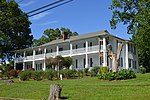Spencer–Penn School
1926 establishments in VirginiaBuildings and structures in Henry County, VirginiaColonial Revival architecture in VirginiaNational Register of Historic Places in Henry County, VirginiaSchool buildings completed in 1926 ... and 1 more
Southern Virginia Registered Historic Place stubs

The Spencer–Penn School is a historic school complex at 30 George Taylor Road in Spencer, Virginia. Its main building, a large brick Colonial Revival building, was built in 1926–27, and is the only surviving non-residential building in the community to be built before World War II. The campus also includes the school's first building, a frame structure built in 1911. The school served the area until 2004, when it was closed by the county school board. The campus is now home to the Spencer–Penn Centre, a non-profit education and special event center. The property was listed on the National Register of Historic Places in 2005.
Excerpt from the Wikipedia article Spencer–Penn School (License: CC BY-SA 3.0, Authors, Images).Spencer–Penn School
Spencer Penn Road,
Geographical coordinates (GPS) Address Nearby Places Show on map
Geographical coordinates (GPS)
| Latitude | Longitude |
|---|---|
| N 36.616666666667 ° | E -80.013888888889 ° |
Address
Spencer Penn Road 100
24165
Virginia, United States
Open on Google Maps









